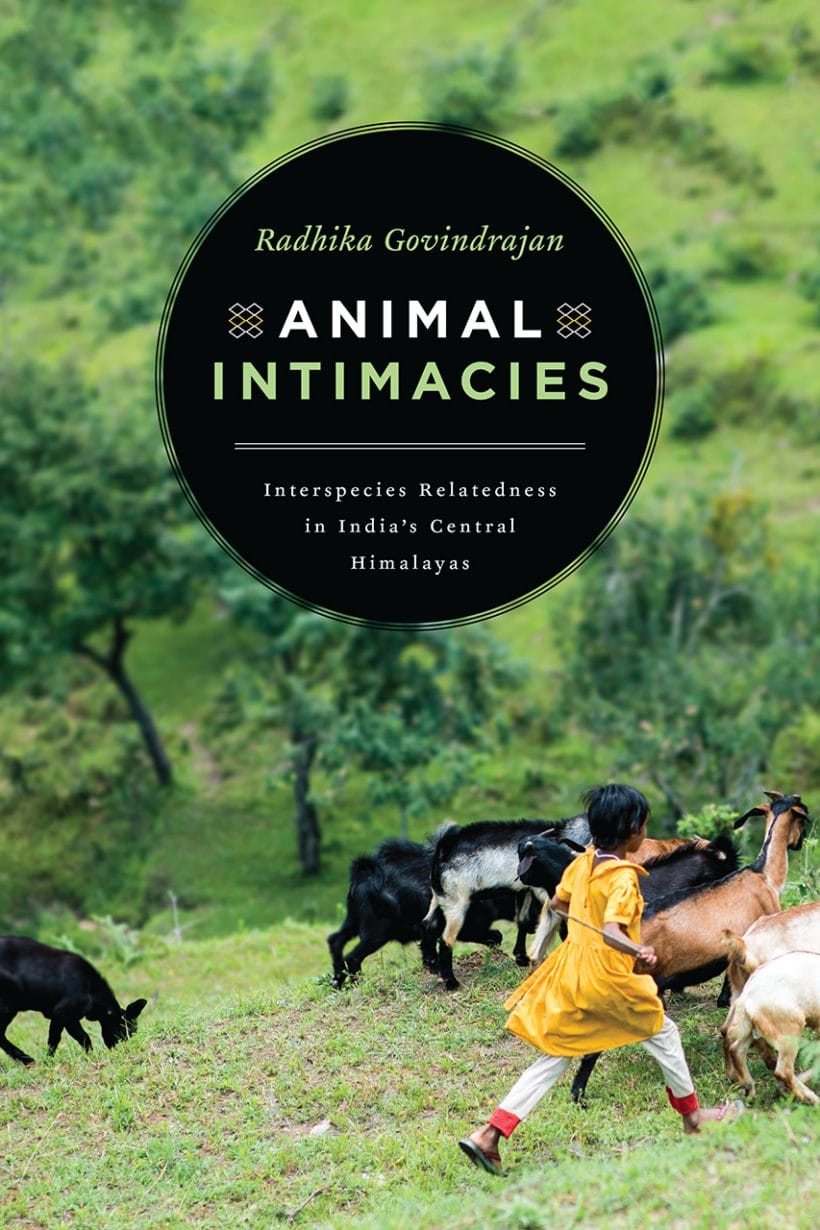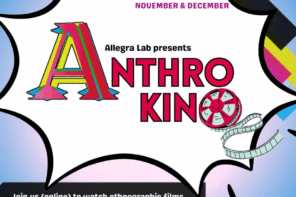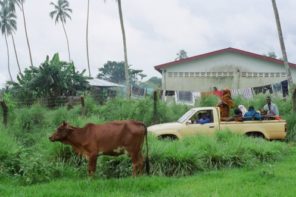The creative disentanglement of human-animal relationships in Animal Intimacies: Interspecies Relatedness in India’s Central Himalayas by Radhika Govindrajan is an important addition to the multispecies storytelling cannon and ethnography. Govindrajan’s vivid exploration of bonds amongst humans and a variety of animal species in daily encounters, in the intimacies of care, love and violence, illuminate the ‘contact zones’ (Haraway 2008: 244) of human and non-human lives, politically and historically. The book reminds us of the importance of storytelling in the Anthropocene, of many kinds of storytelling, to dismantle the Human only history and visiblize our cohabitation with plants, animals, fungi, and microbes. Through her narrations of everyday encounters and species engagement, the author challenges the “hubris of assuming humans work alone” and claims “that human pasts, presents and futures are gathered with the pasts, presents and futures of the multiplicity of non-human animals who share worlds with them” (4). By focusing on relatedness and kin making between humans and other beings, Govindarajan explores the fabric of politics and culture in Kumaon, thus decolonizing our gaze on human history.

The attention to how hierarchy plays out in the daily proximities and entanglements between villagers and animals brings a unique lens to studying subjectivities and culture. Her methodology embodies what Anna Tsing (2015) calls ‘the art of noticing’. Govindrajan adds texture to these intimate species relations by showing animals as thinking and feeling subjects themselves. This is particularly well illustrated in the introductory story of Munni Rekhwaal and her three-year-old calf Radha, whom the author met while on a visit to Simal village in Kumaon with a local NGO representative in the aftermath of a deadly storm. Munni’s house, the first stop in the storm relief visit, visiblizes the knotty and inseparable lives of humans and animals. Govindrajan draws the reader to the intimate bond between Munni and Radha, as she describes how each took to the storm- Munni’s return to her crumbled house and refusal to leave Radha and move to a safe location, Radha taking ill following Munni’s brief absence during the dangerous storm, calling the village healer to attend to Radha, laying pine needles around Radha to provide warmth, and Radha’s gentle response to Munni’s overtures. The affection reveals the deep entanglement of lives and fates. Both well-being and misfortune, as seen in Munni’s insistence on sticking with Radha despite the danger of leopard attack in her ruined house, are intertwined with the bonds and affective relations formed with animals.
Govindrajan draws attention to how living in a village in India’s central Himalaya entails learning how to live with different animals. The chapters in the book explore this mutuality between villagers and animals through rich storytelling on the ritual sacrifice of goats, cow worship, monkey politics, conservation battles over wild hogs, sexual transgressions with bears in folklore and leopard intrusions. The stories elucidate how human animal relatedness is imbricated in the social fabric of Kumaon, especially in the hierarchies of gender, sexuality, caste, class and in religious nationalism and regional marginalization of Paharis from the plains people.
The book is filled with vivid, lively, and diverse interlocutors’ accounts of embodied practices of human animal relatedness in the everyday lives of Kumaonis. The author elaborates the theoretical framework through six stories of relatedness. The first story describes the significance of the ritual sacrifice of goats in Pahari life; as the origin story of the ritual suggests goats are a literal replacement for human children and hence the bond with goats is akin to the affection for children. This chapter addresses the everyday gendered forms of labor in raising goats for sacrifice to the deities and the maternal bond that ties the sacrificer and the sacrificed, here between Neema Di and her goat. Neema Di shares:“Taking care of animals is an everyday ritual. But you see only the ritual of sacrifice and then say that we don’t really love our animals. It pains me every time I see one (of them) die. I feel such mamta (motherly affection) for them” (35). She explains that goat sacrifice in the local context of Kumaon is transactional, “where a lifetime of care and nourishment creates a debt that the sacrificial animal pays with his blood” (49) .
Chapter 3 aptly titled The Cow Herself has Changed navigates the complex lives, history, and character of cows as embodied in the everyday forms of relatedness to different cows and intimate knowledge of the bovine bodies that emerge through caring for cows. This is a significant intervention given the vitriolic rise of Hindu nationalism in India and the coercive enforcement of a ban on cow slaughter. Contrary to Hindutva claims, cow protection is fraught with violence; visible in the subversive rise in cow smuggling and trade by upper caste Hindus and lynching of Dalits, Muslims and Christians who engage in slaughter and skinning. Govindrajan examines how local markers distinguishing Jersey(foreign/modern breed, produced through artificial insemination) and pahari (hill) cows subvert Hindutva politics. For instance, she demonstrates how the government’s rigorous promotion of dairy development and artificial insemination to increase milk production failed to address the friction between the emotive appeal to sacred cows and everyday practices of bodily exchange with cows. Hill people consider Pahari cows to be temperamentally and behaviorally different and claim a kin like affinity for the Pahari cow even though it is not economically lucrative. As noted by interlocutors, the milk generating and well-mannered Jersey cows lack the ritualistic power and strength of the head strong Pahari (native) cows; the latter’s bodily products -milk, urine and dung- considered as pure and providing shakti (strength). This distinction between the pure and the modern bred cows filter into caste practices as well. Puran Ram, a Dalit villager, notes the coming of Jersey changed the practices of choot and achoot (touchability and untouchability) as upper castes do not hesitate to serve milk from Jersey cows to Dalits. He observes: “when the cow changed, everything changed. Now just look at how many people around us are sending these cows to the butcher. Would they have dared to do that with a Pahari cow”?
Contrary to Hindutva claims, cow protection is fraught with violence; visible in the subversive rise in cow smuggling and trade by upper caste Hindus and lynching of Dalits, Muslims and Christians who engage in slaughter and skinning.
The tension between insider and outsider and relatedness is further explored in chapter 4 where the author explores the distinction between Pahari monkeys and the invader monkeys from the plains. Monkeys hold a special place in Hindu religious imaginary as mischievous, ‘good natured rogue’, and hence their behavior, acts of pilfering, are dismissed by locals as playful. However, the infiltration of outsider monkeys complicates this relationship; it opens up a debate about who “belongs and more importantly to whom the mountains belong- who should have moral and material access to the scarce resources of the mountains” (94). The richly playful details of monkey politics vividly elucidate local animosity towards non-pahari settlers and outsider monkeys, and assertiveness of Pahari identity. The chapter guides the reader through behavioral distinctions between locals and outsiders, rural civility of locals versus the cunning, wild and aggressive outsiders. What is important here is the othering and exclusion of the outsiders- monkeys and humans- as they are entirely removed “from the affective circuits of interspecies sociality” (100). It is important to note that this is unlike how locals respond to invasive species such as the Lantana, a recognized alien, known to cause irreparable damage to the forests. To the interlocutors, outsider monkeys embody characteristics of a familiar species but are unfamiliar as individuals. Govindrajan observes: outsider monkeys provide the material metaphor to Pahari’s political and affectiveanxieties about belonging, displacement and expropriation by people from the lowlands.
Chapter 5 focuses on colonial era conservation laws and the prohibition on hunting of wild animals by locals. It specifically addresses the arbitrary construct of ‘wildness’ in colonial and post-colonial conservation laws and local contestations of the distinction between ‘wild’ and ‘domestic’. Pahari accounts of the origin of the wild boar – linked to a one-time incident of a pregnant pig escaping to the forest supposedly under the tutelage of a Dalit worker at the Veterinary Institute (a vestige of colonial establishment) – illuminate local perceptions of the capriciousness of wildlife laws. Interlocutors’ stories, as Govindrajan describes, rather point to the contingent and uneven history of animals: “And these bastards [wild boar] were domesticated [paltu] at some point. Ok, we can’t kill leopards, that I understand. But pigs?” (122). What is convincing in the stories of the wilding of the pigs’ bodies is the messiness and the impossibility of total human mastery over nature. The uneven and contingent nature of the pig’s wildness reveals the fluid and unstable nature of categorizations be they between ‘domestic’ and ‘wild’ or as between ‘wildness’ and ‘civility’ commonly used by privileged groups to subordinate lower caste groups and Dalits. The ‘run away sow’ however, as Govindrajan powerfully claims, embodies the otherwild. The otherwild represents the unruliness of the pigs and the questioning of established structures of domination. More significantly, the otherwild recognizes non-human agency, thus destabilizing human centric imaginaries of the world.
What is convincing in the stories of the wilding of the pigs’ bodies is the messiness and the impossibility of total human mastery over nature.
The final chapter examines “bhalu ki baat”, stories told by women in everyday conversations, in which bears have sex with women, hence questioning the boundaries between humans and animals. It is based on everyday accounts of living in proximity to the animals and observations of bear behavior. The bear stories- of love and violence- reflect their relationship with their husbands, which is sometimes sweet and sometimes marked by violence. The stories, as Govindrajan notes, have bearing on women’s consciousness, feminine expressions of desire and a social world that frowns on their desires. This account opens up the inquiry into interspecies transgression and the “sensuous mingling of human and nonhuman animal bodies” (170). It introduces a radical perspective to a “world in which these norms separating the human from the animal are undone, and the shared tug of animal desire becomes a node of relatedness between human and animal” (171). The epilogue ends with the complicated and entangled relationship between leopards and dogs, exposing the violence at the heart of relatedness. It brings attention to how animals’ lives are joined, and this mutuality includes violence as seen in the relation between dogs and leopards in the villages- where a dog’s life ends in a Leopard’s grasp. As Bhaguli recognizes, “the loss of one life is essential to the renewal of another… “the recursive play ties live together in knots of relatedness” (176).
The vivid accounts of everyday practices of villagers living with animals, and the inclusive approach to human species relatedness in her stories enables the reader to recognize the multiplicity and diversity of experiences and subjectivities among different animals. By highlighting the connections, hierarchies, and differences that constitute and make human-animal interactions, the book elegantly argues that humanism is mixed up in relations with other species. The decentering of human experience and the recognition of the many forms of relationality, entanglements and involvement with other species, brings an extremely important addition to debates on the Anthropocene.
Govindrajan’s attention to vulnerabilities in society through multispecies history opens up possibilities for decolonizing the Anthropocene.
The acknowledgement of the Anthropocene by historians has been a critical turning point in recognizing the superficiality of nature-culture binaries and the destructive role of humans on a planetary scale (Chakrabarty, 2009). The rewriting of history to account for the human transformation of landscapes in the industrial era is no doubt a significant intervention. However, as multispecies ethnography shows, this history fails to address the question of unequal agency and unequal vulnerabilities, and remains human centered (Nixon, 2011). The attention to systemic characteristics that focus on the geological agency of human species or the global history of capital obliterate how humans have cohabited with other species and become with other species, how social relations are not limited to humans but thrive in the interspecies exchanges between plants, animals, fungi, and microbes, how species relatedness shapes human history and politics, and how vulnerabilities are created and subverted. Multispecies entanglements and interactions holds invaluable lessons to how we may address anthropogenic climate change, extractive capitalism, environmental burdens, and viral outbreaks such as Ebola, HIV, Covid-19 etc.
Govindrajan’s attention to vulnerabilities in society through multispecies history opens up possibilities for decolonizing the Anthropocene. It offers agency to the marginalized and challenges the inequalities that are at the crux of the Anthropocene. Her careful and detailed storytelling of village life in Central Himalayas, illuminates how cultural, social, political and economic forces are shaped in multispecies relationships. The book shows promising possibilities for envisioning how post humanism may “engage with the lessons of post colonialism and vice versa” (179).
Reference:
Carsten, Janet (2000). Cultures of Relatedness: New Approaches to the Study of Kinship
Cambridge University Press.
Chakrabarty, Dipesh (2009). “The Climate of History: Four Theses.” Critical Inquiry 35, no. 2: 197–222.
Gibson, Hannah and Venkateswar, Sita (2015). Anthropological Engagement with the Anthropocene: A Critical Review. Environment and Society , Vol. 6, pp. 5-27
Haraway, Donna. J. (2008). When Species Meet. Minneapolis, MN: University of Minnesota Press.
Nixon, Rob. (2011). Slow violence and the environmentalism of the poor. Cambridge, Mass: Harvard University Press.
Tsing, Anna (2015). The Mushroom at the End of the World: On the Possibility of Life in Capitalist Ruins. Princeton, NJ: Princeton University Press.









